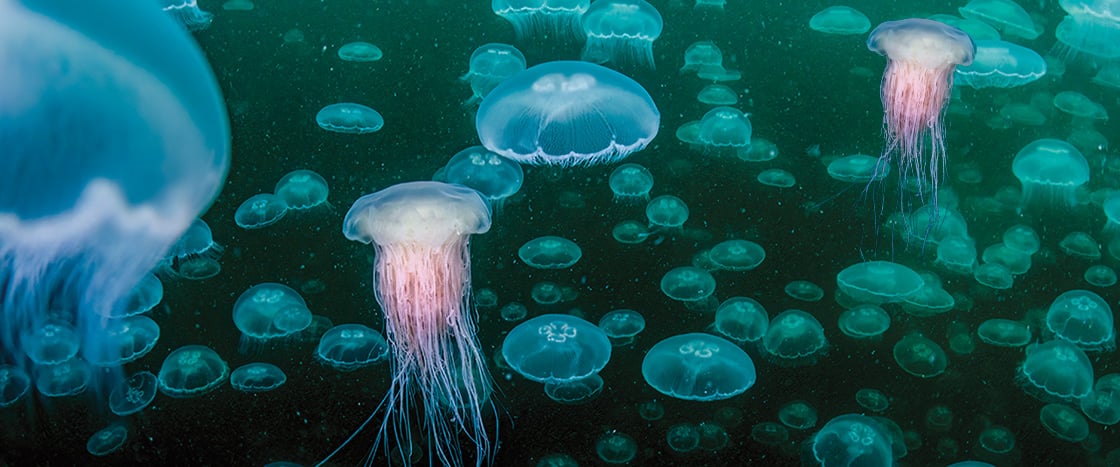Deadly sea creatures are taking over the oceans. They scare swimmers. They stop ships.
What are these monsters? A gang of sharks? An army of orcas? Nope. These creepy creatures are jellyfish.

These boneless bags of goo are causing problems.
Learning Objective: Children will examine cause and effect through a nonfiction text about jellyfish.
Deadly sea creatures are taking over the oceans. They scare swimmers. They stop ships.
What are these monsters? A gang of sharks? An army of orcas? Nope. These creepy creatures are jellyfish.
Jellies Everywhere
Jellyfish are sometimes called jellies. They have lived on Earth for millions of years. They were around before the dinosaurs! So what are jellyfish?
They are not really fish. They’re invertebrates (in-VEHR-tuh-brayts). That means they have no backbone. In fact, they don’t have any bones! They don’t have a brain, teeth, or blood either. Many jellyfish don’t even swim. They just float through the water.
But right now, millions and millions of jellyfish rule the oceans.
Shutterstock.com
These rabbitfish snack on a jellyfish.
Good for Jellies
Why are there so many jellies right now? Scientists think there are a few reasons. One is that people catch a lot of fish. Fish such as tuna and swordfish eat jellyfish. As humans catch more of these fish, fewer of them are left to eat the jellies.
Water pollution plays a part too. Pollution from people can hurt sea animals. But most jellyfish do well in dirty waters.
Even global warming may be good for jellyfish. Oceans are getting warmer, but jellyfish don’t seem to mind. In fact, some jellies have more babies in warmer water. And jellyfish already have a lot of babies. They can lay up to 45,000 eggs at a time!
Shutterstock.com
Some jellyfish love warm water.
A Powerful Sting
Jason Jones Travel Photography/Getty Images
Look out! Jellyfish can sting you at the beach.
People are worried that there are too many jellies. Why? Well, jellyfish may look like bags of goo, but they can cause problems.
First, jellyfish can ruin a day at the beach. Some jellies have tentacles covered with stingers. If a stinger touches a swimmer—ouch!
Jellyfish sting about 150 million people around the world each year. These stings can really hurt, and they can leave painful red marks on your skin.
U.S. Navy photo by Mass Communication Specialist 2nd Class Kaila V. Peters/DoD/Gado/Alamy Stock Photo
This Navy ship was stopped by jellies.
More Jelly Problems
Savannah Morning News-USA TODAY NETWORK/Imagn Content Agency
A net full of jellies!
Big groups of jellyfish can cause bigger problems. One jellyfish may not be able to do much, but hundreds of them are a powerful force.
One day, they stopped a United States Navy ship! This ship was big and powerful. It was meant to fight battles, but it was no match for the jellyfish.
Hundreds of jellies got into the pumps that help the ship work. The ship shut down, and everyone had to get off.
And here’s one more problem caused by swarms of jellyfish. They can be a headache for fishermen. Instead of nets full of fish, fishers are pulling up nets filled with jellies!
Jellyfish for Dinner
Shutterstock.com
So how can we stop the jellyfish? Here’s something people can do: Eat a tasty jellyfish snack!
Chefs around the world are turning jellyfish into tasty meals. They have made jellyfish salad, jellyfish chips, and even jellyfish ice cream.
Jellyfish are good for you too! A bunch of jellyfish chips is healthier than potato chips.
Someday soon, jellies might be on the menu at a restaurant near you. Would you order jellyfish for dinner?
A Jellyfish Snack
Would you eat these jellyfish foods?
Jordan Lye/Getty Images
Would you eat a cold jellyfish salad?
Shutterstock.com
Would you eat pizza with melted jellies?
Courtesy of Kristoff Styrbaek
Would you eat crunchy jellyfish chips?
Vince Talotta/Toronto Star via Getty Images
Would you eat sweet jellyfish ice cream?
More About the Article
English Language Arts Focus
Comprehension of a nonfiction text through speaking and listening
Science Focus
Jellyfish/ocean life
Vocabulary
invertebrates, pollution, tentacles, chefs
Implementation
Pairings and Text Connections
Before-Reading Resources
Suggested Reading Focus
After-Reading Skills Practice
Extension Activity
Skills: Writing (15 minutes)